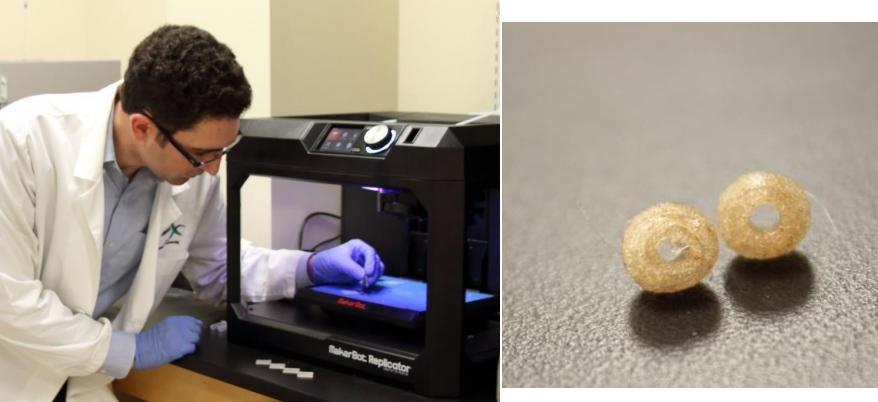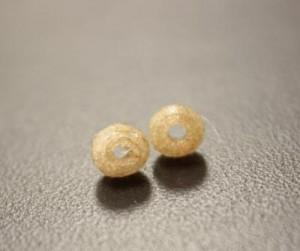 The number of medical applications for 3D printing seems to expand on a daily basis. We have seen all sorts of amazing uses for the technology, from prosthetics, to implants, to even human cells being printed for medical use. Despite the innovations taking place at a rapid rate, many of these applications are limited by the need for expensive, often $300,000+ machines, in order to make the technologies available to particular hospitals.
The number of medical applications for 3D printing seems to expand on a daily basis. We have seen all sorts of amazing uses for the technology, from prosthetics, to implants, to even human cells being printed for medical use. Despite the innovations taking place at a rapid rate, many of these applications are limited by the need for expensive, often $300,000+ machines, in order to make the technologies available to particular hospitals.
One breakthrough, however, the work of researchers at Louisiana Tech University, is using affordable desktop 3D printers like the MakerBot Replicator to possibly change the way we treat cancer patients as well as those fighting infection.
The researchers, which included both faculty and doctoral students within the school’s biomedical engineering and nanosystems engineering programs, worked together to create their own custom 3D printer filament. The team created a filament extruder which has allowed them to make a biocompatible material which can easily be used within a MakerBot Replicator machine, or other affordable 3D printer, that also includes medical compounds such as antibiotics or chemotherapeutic drugs.
“After identifying the usefulness of the 3D printers, we realized there was an opportunity for rapid prototyping using this fabrication method,” said Jeffery Weisman, a doctoral student in Louisiana Tech’s biomedical engineering program. “Through the addition of nanoparticles and/or other additives, this technology becomes much more viable using a common 3D printing material that is already biocompatible. The material can be loaded with antibiotics or other medicinal compounds, and the implant can be naturally broken down by the body over time.”
Weisman teamed with Connor Nicholson, a doctoral candidate in nanosystems engineering, as well as Phoenix, Arizona based Extrusionbot, LLC, who supplied materials for their efforts. Basically, the idea was to print out custom drug emitting implants, which naturally breakdown within the human body, slowly releasing that drug to a particular area within a patient.
“One of the greatest benefits of this technology is that it can be done using any consumer printer and can be used anywhere in the world,” Weisman said.
This new 3D printing application will overcome issues which doctors have with current drug delivery methods. At current time, the majority of drug delivery implants come in the form of beads. These beads are molded out of hand-mixed bone cements, which contain carcinogens. The beads do not break down in the body, meaning that a second surgery is usually required in order to remove them.
“Currently, embedding of additives in plastic requires industrial-scale facilities to ensure proper dispersion throughout the extruded plastic,” explains Dr. David K. Mills, the lab directory that Weisman works out of. “Our method enables dispersion on a tabletop scale, allowing researchers to easily customize additives to the desired levels. There are not even any industrial processes for antibiotics or special drug delivery as injection molding currently focuses more on colorants and cosmetic properties.”
Additionally, researchers are able to print the implantable beads in customized shapes, allowing them to control the total surface area, and thus the speed that the drugs are delivered within the body at. This new process could make treating cancer, as well as infection, a more localized process, resulting in less side effects, and a more efficient treatment in general.
Let’s hear your thoughts on this awesome new application of affordable 3D printing within the medical field, in the 3D printed drug implant forum thread on 3DPB.com.
[Source: latech.edu]
Subscribe to Our Email Newsletter
Stay up-to-date on all the latest news from the 3D printing industry and receive information and offers from third party vendors.
You May Also Like
Gorilla Sports GE’s First 3D Printed Titanium Cast
How do you help a gorilla with a broken arm? Sounds like the start of a bad joke a zookeeper might tell, but it’s an actual dilemma recently faced by...
Nylon 3D Printed Parts Made More Functional with Coatings & Colors
Parts 3D printed from polyamide (PA, Nylon) 12 using powder bed fusion (PBF) are a mainstay in the additive manufacturing (AM) industry. While post-finishing processes have improved the porosity of...
$25M to Back Sintavia’s Largest Expansion of Metal 3D Printing Capacity Since 2019
Sintavia, the digital manufacturing company specializing in mission-critical parts for strategic sectors, announced a $25 million investment to increase its production capacity, the largest expansion to its operations since 2019....
Velo3D Initiates Public Offering in a Bid to Strengthen Financial Foundations and Drive Future Growth
Velo3D (NYSE: VLD) has been among a number of publicly traded 3D printing firms that have attempted to weather the current macroeconomic climate. After posting a challenging financial report for 2023,...
































